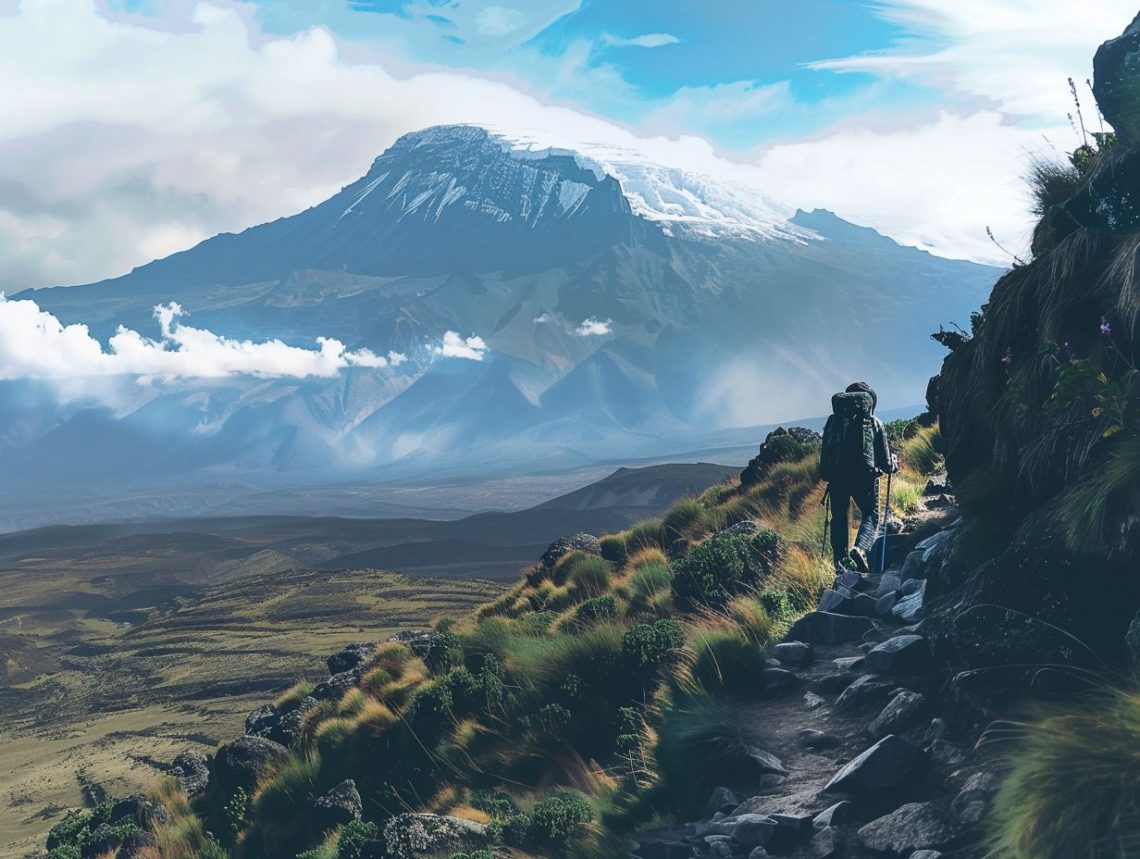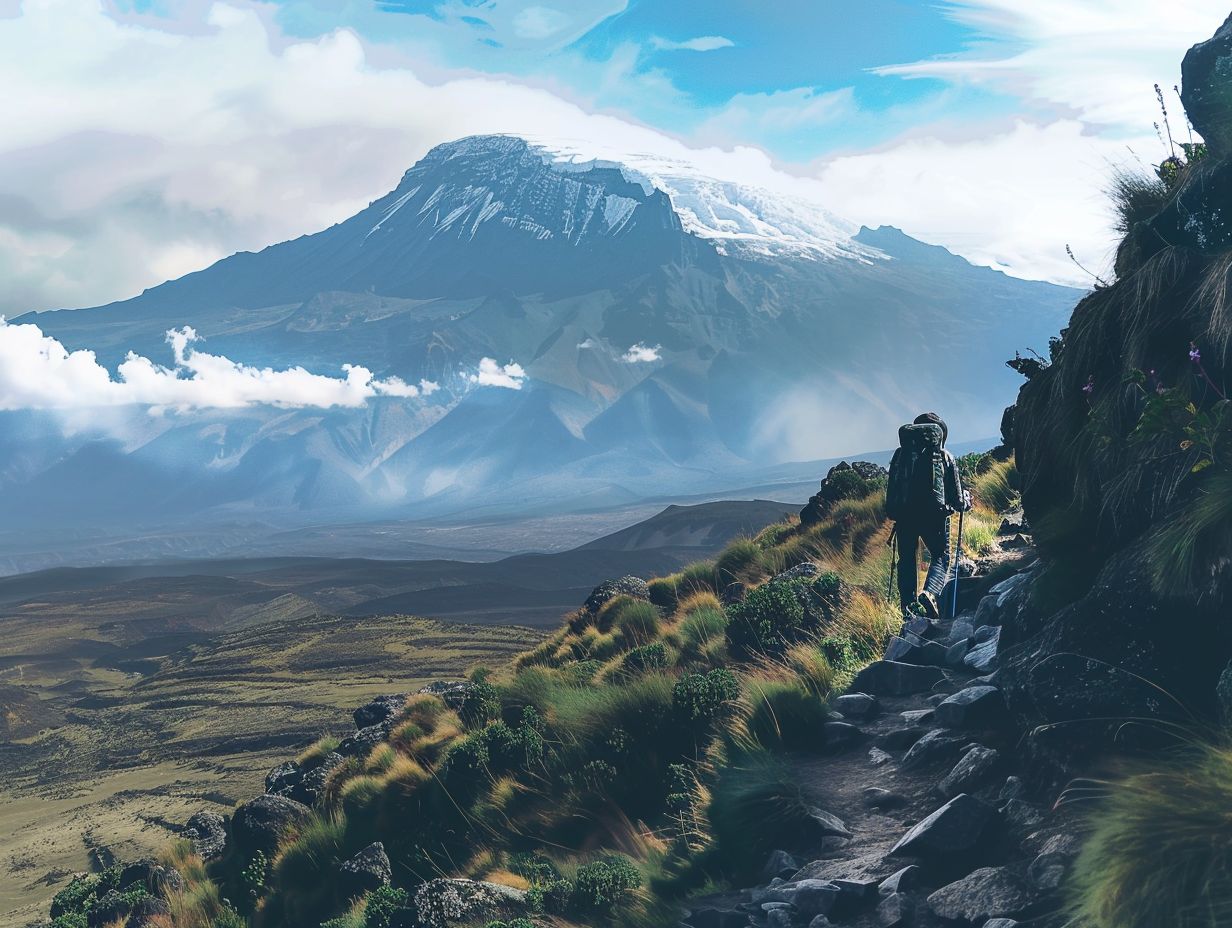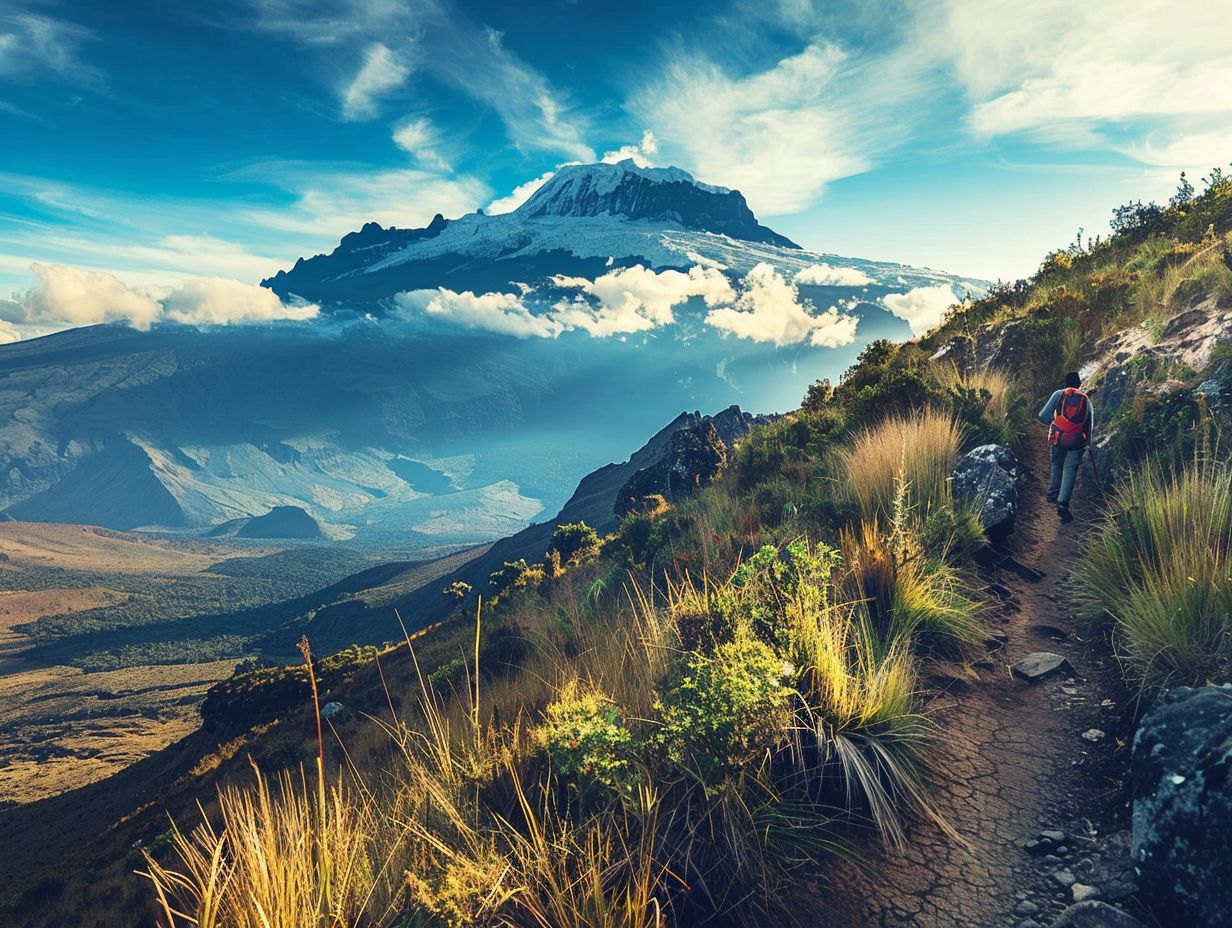
Climb Kilimanjaro Without A Guide
Thinking of climbing Kilimanjaro without a guide? It’s definitely possible, but it’s not a decision to take lightly.
In this article, we’ll explore the requirements for solo climbers, the pros and cons of going guideless, alternative routes to consider, safety measures to prioritize, and ultimately, whether it’s a feasible and safe endeavor.
Whether you’re a seasoned hiker looking for a new challenge or a novice adventurer seeking a unique experience, this guide will help you navigate the ins and outs of climbing Africa’s highest peak without a guide.
Key Takeaways:

- Climbing Kilimanjaro without a guide requires physical fitness, hiking experience, and permits or fees.
- Pros of climbing without a guide include lower costs and more independence, while cons include safety concerns and navigation difficulties.
- Alternative routes for climbing Kilimanjaro without a guide include Machame, Lemosho, Marangu, Rongai, and Umbwe.
What are the Requirements for Climbing Kilimanjaro Without a Guide?
When considering climbing Kilimanjaro without a guide, several requirements need to be met to ensure a safe and successful trek.
1. Physical Fitness
Physical fitness is paramount when embarking on a Kilimanjaro climb without a guide. The ascent involves challenging terrain, high altitudes, and long hours of hiking, requiring trekkers to be in excellent physical condition.
Endurance training plays a crucial role in preparing for the physical demands of climbing Kilimanjaro.
Trekkers must focus on activities like running, hiking with a weighted backpack, and cardio exercises to build stamina and cardiovascular endurance.
Strength exercises, including squats, lunges, and core workouts, are essential to develop the muscular strength needed to tackle steep inclines and rocky terrain.
Altitude acclimatization techniques such as gradual ascent, hydration, and rest days are vital to prevent altitude sickness and ensure a successful summit attempt.
2. Experience in Hiking and High Altitude
Having prior experience in hiking and high-altitude environments is essential for those planning to climb Kilimanjaro without a guide. Familiarity with challenging terrains, altitude sickness symptoms, and proper trekking protocols is crucial for a successful ascent.
The trek to its summit involves traversing diverse terrains, from lush rainforests to barren alpine deserts, testing the endurance and adaptability of even the most seasoned hikers.
At elevations exceeding 19,000 feet, climbers face the looming threat of altitude-related risks such as acute mountain sickness, pulmonary edema, and cerebral edema.
Experienced hikers are attuned to recognizing the early signs of altitude sickness, ensuring a safer journey for themselves and their teammates.
Their leadership skills, familiarity with the mountain’s nuances, and quick decision-making abilities can make all the difference in navigating the unpredictable conditions of Kilimanjaro.
2. Permits and Fees
Obtaining the necessary permits and paying fees to access Kilimanjaro National Park is a critical step for climbers undertaking the journey without a guide. These permits cover camping areas, conservation fees, and park regulations to ensure a sustainable and regulated trek.
For climbers, the primary permit required is the Kilimanjaro National Park Entry Permit, which grants access to the park and the trails.
Climbers need a camping permit to stay overnight at designated campsites along the route.
The park fees typically include a daily conservation fee, and there might be separate charges for rescue fees and community development fees.
In terms of regulations, climbers must adhere to the park’s guidelines on waste disposal, respecting wildlife, and following designated routes to protect the fragile ecosystem.
What are the Pros and Cons of Climbing Kilimanjaro Without a Guide?
Exploring the pros and cons of climbing Kilimanjaro without a guide offers valuable insights into the unique experiences, challenges, and considerations faced by trekkers opting for independent ascents.
Pros:

Climbing Kilimanjaro without a guide can provide a more personalized and immersive experience for trekkers and achieve a sense of accomplishment by navigating independently.
For adventurers seeking a deeper connection with the environment, going guide-less on Kilimanjaro opens up opportunities to spot elusive wildlife that call the mountain home.
Each step taken without a guide offers a chance to appreciate nature’s raw beauty without distractions, fostering a heightened awareness of the surroundings.
The sense of enablement gained from conquering the mountain solo can be truly transformative, making the journey a memorable and rewarding experience.
Cons:
Climbing Kilimanjaro without a guide poses safety risks due to the lack of professional support, guidance, and emergency assistance typically provided by experienced operators.
Independent trekkers may face challenges related to waste management, littering, and environmental impact on the mountain.
One of the key drawbacks of attempting to summit Kilimanjaro without a guide is the absence of a safety net.
Without a knowledgeable guide, climbers are more vulnerable to potential hazards such as altitude sickness, extreme weather conditions, and navigation errors.
In cases of emergency, solo trekkers may find themselves isolated without immediate access to help or rescue services, putting their safety at significant risk.
Without the support of an experienced team, the chances of effectively managing medical emergencies or handling unexpected situations decrease substantially.
Without professional guidance, individuals may unknowingly contribute to ecological damage through improper waste disposal, erosion, disruption of local flora and fauna, and disturbance to the fragile ecosystem.
What are the Alternative Routes for Climbing Kilimanjaro Without a Guide?
Discovering the alternative routes for climbing Kilimanjaro without a guide presents trekkers with diverse options to tailor their ascent based on personal preferences, desired challenges, and weather conditions.
Each route offers unique experiences, distinct terrains, and varying levels of facilities such as huts and camping sites.
1. Machame Route
The Machame Route, known for its diverse landscapes, lush vegetation, and captivating sunrise views, offers trekkers a challenging yet rewarding journey to the summit of Kilimanjaro.
This route combines scenic beauty with moderate difficulty, attracting climbers seeking a memorable experience.
One of the key highlights of the Machame Route is its varying vegetation zones, transitioning from lush rainforest to alpine desert, providing trekkers with a unique botanical experience.
As climbers ascend through these zones, they witness a remarkable change in flora and fauna, adding to the adventure.
The route not only offers picturesque landscapes but also presents breathtaking sunrise vistas from strategic points like Stella Point and Uhuru Peak.
The sunrise spectacle from these high altitudes is truly awe-inspiring, making all the efforts put into the climb worthwhile for those who brave the challenges.
2. Lemosho Route
The Lemosho Route is renowned for its varied terrain, pristine glaciers, and thrilling challenges, making it a popular choice for experienced climbers seeking an adventurous and less crowded path to Kilimanjaro’s summit.
Traversing through lush rainforests, moorlands, alpine deserts, and the arctic summit zone, the Lemosho Route presents a truly diverse trekking experience.
Trekkers encounter the spectacular Shira Plateau, the iconic Lava Tower, and the challenging Barranco Wall, all contributing to the route’s allure.
The opportunity to witness breathtaking sunrises and sunsets amidst Kilimanjaro’s unique ecosystems adds an extra layer of magic to the journey, enticing climbers from around the world.
2. Marangu Route
The Marangu Route, often referred to as the ‘Coca-Cola Route,’ is known for its hut accommodations, well-trodden paths, and historical significance in Kilimanjaro climbing.
While offering comfortable huts for overnight stays, this route faces challenges related to waste management and environmental impact due to its popularity.
Named after a popular refreshment drink due to its relatively easier trekking options, the Marangu Route draws climbers for its accessible terrain and the allure of sleeping in huts.
These huts provide a unique shelter experience compared to other routes on Kilimanjaro, fostering a sense of community among climbers. The historical aspect of the route dates back to when it was the first established path on the mountain.
The increased foot traffic brings about environmental concerns, prompting efforts for waste management programs to maintain the pristine natural beauty of the surrounding landscapes.
Climbers and tour operators are continually encouraged to adhere to leave-no-trace principles and support conservation initiatives to preserve the fragile ecosystem of Kilimanjaro.
3. Rongai Route

The Rongai Route, offering a serene trek through diverse terrains and gradual ascents, provides climbers with excellent opportunities for acclimatization and panoramic views.
With its gradual ascents, trekkers can acclimatize effectively, reducing the risk of altitude-related issues and panoramic views greet adventurers along the way.
From lush forests to wide-open moorlands, the route captivates with its diversity.
Climbers looking to escape the hustle and bustle of busier trails find solace in the tranquility of the Rongai Route.
4. Umbwe Route
The Umbwe Route, renowned for its steep and challenging paths, offers adventurous climbers a thrilling yet demanding journey to Kilimanjaro’s summit.
This route is characterized by its rugged terrain, dense vegetation, and occasional wildlife sightings, providing trekkers with a unique and adrenaline-pumping experience.
The unpredictable encounters with wildlife, such as Colobus monkeys and various bird species, create a sense of exhilaration and remind climbers of the raw beauty of nature that surrounds them.
The challenge of conquering Kilimanjaro via the Umbwe Route is not just a physical feat but also a profound connection with the untamed wilderness.
What are the Safety Measures to Take When Climbing Kilimanjaro Without a Guide?
Prioritizing safety measures is crucial for individuals climbing Kilimanjaro without a guide to mitigate risks, ensure preparedness, and enhance the overall trekking experience.
1. Proper Gear and Equipment
Ensuring that climbers have the proper gear and equipment tailored for Kilimanjaro’s challenging terrain and high altitudes is essential for their safety and comfort.
From insulated clothing to sturdy hiking boots, the gear selection plays a crucial role in the success of the trek. Layering is key to adapting to the varying weather conditions.
This includes a base layer to wick moisture away from the body, insulating layers to trap warmth, and a waterproof shell for protection against rain and wind.
Footwear is another critical aspect, with robust hiking boots offering ankle support and traction on rocky terrain. It’s advisable to break them in before the climb.
Essentials for the backpack include a hydration system, energy-rich snacks, a headlamp, a first-aid kit, and sunscreen.
These items are vital for sustenance, navigation, safety, and health maintenance during the trek.
Altitude-specific gear such as portable oxygen canisters may be necessary at higher elevations where oxygen levels are lower.
It’s crucial to understand how to use these devices correctly in case of altitude-related symptoms.
2. Acclimatization
Acclimatization is a crucial aspect of climbing Kilimanjaro without a guide, allowing trekkers to adapt to the increasing altitudes gradually.
Proper acclimatization techniques, including slow ascent rates and sufficient hydration, are vital to prevent altitude-related illnesses.
As you ascend the majestic slopes of Kilimanjaro, the thinning air and decreasing oxygen levels present challenges that must be met with caution and preparation.
Altitude sickness can strike unexpectedly, making it imperative to listen to your body and recognize the symptoms early on.
Implementing strategies such as breathing exercises and adequate rest at higher camps can greatly aid in acclimatization and reduce the risk of altitude-related complications.
Maintaining hydration levels by drinking plenty of water and avoiding alcohol and caffeine can help regulate your body’s response to higher altitudes.
3. Navigation Skills
Proficient navigation skills are vital for climbers on Kilimanjaro without a guide, enabling them to traverse terrains, navigate routes, and ensure a secure descent.
Understanding map reading, route identification, and orientation techniques are critical for a successful expedition.
Map interpretation is crucial for plotting the safest course up and down Kilimanjaro. By studying topographical maps, climbers can anticipate elevation changes, hazards, and rest points along their journey.
Effective route planning involves considering factors like weather conditions, time of day, and individual stamina to determine the best path to the summit.
Additionally, terrain assessment skills help in recognizing unstable ground, icy patches, or steep inclines that require extra caution.
Conclusion

While it is technically possible to climb Kilimanjaro without a guide, the safety and success of such an expedition heavily depend on the preparation, experience, and decision-making of the individual or team undertaking the journey.
Assessing personal capabilities, understanding the risks involved, and prioritizing safety measures are paramount in ensuring a safe and fulfilling climbing experience on Africa’s iconic mountain.
Planning is crucial when embarking on an independent ascent of Kilimanjaro.
- Researching the routes, understanding the terrain, and packing appropriate gear are initial steps.
- During the journey, monitoring weather conditions and acclimatizing properly to avoid altitude sickness are essential.
- Without a guide, the responsibility for navigation, first aid, and emergency protocols falls entirely on the climbers.
- Forming a cohesive team, communicating effectively, and being knowledgeable about rescue procedures can make all the difference in addressing unexpected challenges that may arise.
Frequently Asked Questions
1. Can I climb Kilimanjaro without a guide?
A: Yes, it is possible to climb Kilimanjaro without a guide. However, it is highly recommended to hire a guide for safety and to ensure a successful climb.
2. What are the dangers of climbing Kilimanjaro without a guide?
A: Climbing Kilimanjaro without a guide can be dangerous as the mountain is known for its unpredictable weather and challenging terrain. Without a guide, hikers may get lost or injured, leading to potentially life-threatening situations.
3. Do I need any special skills to climb Kilimanjaro without a guide?
A: Yes, you will need some basic mountaineering skills and previous hiking experience to safely climb Kilimanjaro without a guide. It is also important to be physically fit and mentally prepared for the physically demanding trek.
4. What are the benefits of climbing Kilimanjaro without a guide?
A: Climbing Kilimanjaro without a guide can be a rewarding and adventurous experience. It allows for a more independent and personal journey, and can also be a more budget-friendly option compared to guided climbs.
5. Are there any rules or regulations for climbing Kilimanjaro without a guide?
A: Yes, it is required to obtain a climbing permit and register with the Kilimanjaro National Park before attempting to climb the mountain without a guide. It is also recommended to follow the park’s rules and regulations for safety and preservation of the environment.
6. What are some tips for climbing Kilimanjaro without a guide?
A: Some tips for climbing Kilimanjaro without a guide include:
– Do thorough research and preparation before attempting the climb
– Bring proper gear and equipment, including a reliable map and compass
– Stay on marked trails and be aware of potential hazards
– Acclimatize properly and listen to your body’s signals
– Inform someone of your plans and check in regularly for safety.